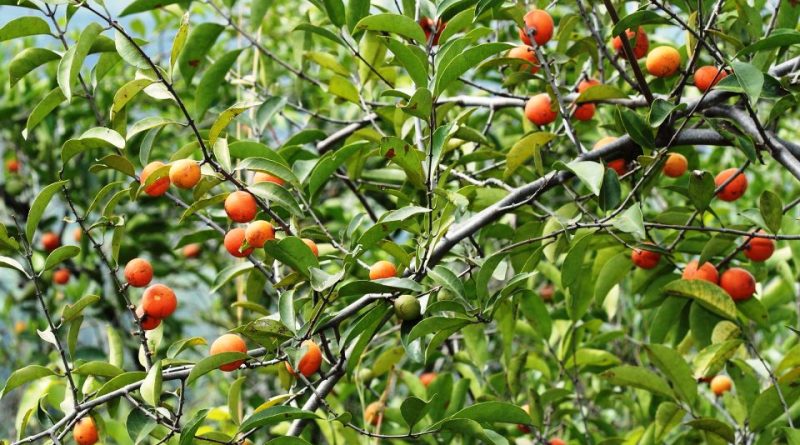Salacia reticulata
Salacia reticulata
Kothala himbutu (Salacia reticulata Wight) is a shrub species belonging to the Celastraceae family.
Systematics –
From a systematic point of view it belongs to:
Eukaryota Domain,
Kingdom Plantae,
Subarign Tracheobionta,
Spermatophyta superdivision,
Magnoliophyta Division,
Magnoliopsida class,
Subclass Rosidae,
Celastrales Order,
Celastraceae family,
Subfamily Salacioideae,
Genus Salacia,
S. reticulata species.
Etymology –
The term Salacia of the genus was dedicated by Linnaeus to Salacia, marine goddess of marine mythology, keeper of the sea depths, wife and queen of Neptune, as told by Varro and reported by Seneca. According to De Theis, the name of Salacia derives from sal salt, sea, referring to the salty element abode of this divinity.
The specific reticulate epithet refers to the fact that it has a reticulum, diminutive of network: due to the presence of reticular veins or ribs.
Geographic Distribution and Habitat –
Salacia reticulata is a plant whose native range is found in Sri Lanka and the Andaman Islands.
Its natural habitat is that of forests as in the dry area of Sri Lanka.
Description –
Salacia reticulata is a perennial, woody climbing shrub.
The plant has a dichotomous branching.
The bark is smooth, greenish gray, thin and white internally.
The leaves are opposite and elliptical-oblong in shape. The leaves have acute bases, sharply pointed apexes and a margin with small rounded teeth.
The flowers are bisexual and arranged in clusters of 2-8 at the axis of the leaves. They are greenish white to greenish yellow in color.
The fruit is a globose and tubercular drupe. The drupe takes on a pink-orange color when ripe. Inside there are 1-4 seeds, each similar to an almond.
Cultivation –
Salacia reticulata is a climbing plant that, like others of its genus, grows naturally in tropical regions.
This plant has long been used in the medicinal field and is mostly harvested in its natural state.
Propagation can take place both by seed and by cutting.
Customs and Traditions –
Salacia reticulata is a plant native to Sri Lanka and the Andaman Islands, known by the name of kothala himbutu (කොතල හිඹුටු) in Sinhala.
This plant has been known to Indian Ayurvedic medicine for centuries.
The chemical constituents of the root bark contain polyphenols such as salacinol, kotalanol and mangiferin.
This plant, as mentioned, is widely used as a traditional Ayurvedic medicine for antidiabetic purposes, in early diabetes.
Salacia reticulata extracts have been used in Ayurveda medicine for the treatment of early diabetes, rheumatism and gonorrhea; these have been shown to have an anti-obesity effect and suppress hyperglycemia.
Research and studies have been carried out in this regard. A significant dose-dependent decrease in body weight gain, accumulation of visceral and subcutaneous fat, and improvement in abnormal glucose tolerance, hypertension and peripheral neuropathy were observed in TSOD mice. In addition, hepatocellular swelling, fatty degeneration of hepatocytes, infiltration of inflammatory cells, and unicellular necrosis were observed on histopathological examination of the liver in TSOD mice. Salacia extract significantly improved these symptoms during treatment. Based on the above results, it is concluded that Salacia extract has significant potential for preventing obesity and associated metabolic disorders, including the development of metabolic syndrome.
Preparation Method –
Salacia reticulata uses the bark of the root for its content in polyphenols with particular aptitude for the treatment of early diabetes and other metabolic disorders.
Various types of extracts can be prepared from the root bark used in this regard.
Guido Bissanti
Sources
– Acta Plantarum – Flora of the Italian Regions.
– Wikipedia, the free encyclopedia.
– Useful Tropical Plants Database.
– Conti F., Abbate G., Alessandrini A., Blasi C. (ed.), 2005. An annotated checklist of the Italian vascular flora, Palombi Editore.
– Pignatti S., 1982. Flora of Italy, Edagricole, Bologna.
– Treben M., 2000. Health from the Lord’s Pharmacy, Advice and experiences with medicinal herbs, Ennsthaler Editore.
Warning: Pharmaceutical applications and alimurgical uses are indicated for informational purposes only, they do not represent in any way a medical prescription; therefore no responsibility is taken for their use for curative, aesthetic or food purposes.
Photo source:
– https://powo.science.kew.org/taxon/urn:lsid:ipni.org:names:162694-1
– https://www.gbif.org/species/5579938


